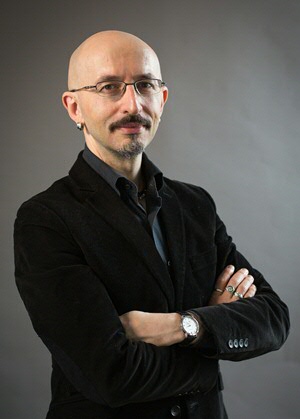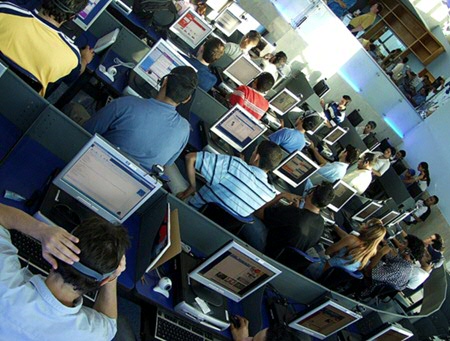Prof. Antonio Casilli: ‘The back office of AI is not as bright as Silicon Valley suggests’
Facial recognition, ChatGPT and voice assistants like Siri or Google Home: more and more people face the staggering applications of artificial intelligence (AI). Far less known are the millions of human 'clickworkers' needed to make AI possible. Antonio Casilli, professor of sociology at the Institut Polytechnique de Paris, talks about the often dire working conditions of these invisible workers in his lecture 'How Artificial Intelligence fosters Global Inequalities'. The event is organised by Panoptiwork and the Jantina Tammes School of Digital Society, Technology and AI and will take place on 20 November at the House of Connections. In this interview, Casilli shares a preview of his lecture.
Text: Jelle Posthuma
© Alexandre Enard
The professor starts his story with a disclaimer. 'I am not a mainstream researcher in the field of artificial intelligence. My background is in social sciences: I was trained as an economist and later shifted to sociology. From that background, I look at how technology is produced. In my lecture, I talk about the production of AI and how this promotes global inequality.’
Secret ingredients
Artificial intelligence gets a lot of attention in recent years, Casilli knows. In particular, so-called 'large language models' like ChatGPT are incredibly popular. These forms of artificial intelligence are usually developed using 'machine learning', in which a computer system learns to recognise patterns in large amounts of data. 'We train machines by providing them with huge amounts of examples,' Casilli explains.
This training is no easy task, the researcher knows. First of all, it requires computers with enormous computing power. In addition, it requires a huge amount of data. ‘These data are the secret ingredient of AI and are often represented as raw materials, as if they just exist in nature, which researchers only have to exploit. However, this is not the case. Quality data are produced. Even in 2023, there is only one way this can be done: by humans producing, annotating and verifying data.'
Silicon Valley
It is precisely this industry, where people train machines to recognise patterns, that Casilli has researched. 'Often AI workers are presented by the media as engineers at Google in Silicon Valley, but this is only a fraction of the people working in the AI industry.' The bulk of workers, often described as 'clickworkers', 'microworkers' or 'cloudworkers', come from low-wage regions. According to recent World Bank estimates, 100 million to as many as 400 million people now work in this industry. 'For our research, we visited these 'microworkers'. For a time, we shared their workspace, observing and documenting their working conditions.'
According to the professor, there is a semblance of 'magical thinking' around artificial intelligence. 'It is often described as superhuman. But the back office of AI is not as bright as Silicon Valley would like us to think. This lack of transparency benefits companies by preventing regulations and maintaining investors.' Surprisingly, much is known about the 'supply chain' of artificial intelligence, Casilli states. For example, Time Magazine wrote about poorly paid moderators in Kenya a few months after ChatGPT launched in 2022. The article got a lot of attention but caused little stir. ‘It is no secret that it takes millions of people to train AI. But it still leads to little reaction, including from regulators.'
Simple and poorly paid

Casilli researched the working conditions and social and demographic profiles of data workers in four low-, middle- and high-income countries (Venezuela, Madagascar, Brazil and France). In the supply chain of AI, the global North benefits from economic progress through innovations in AI, while the global South mainly provides cheap labour, the professor argues. In doing so, the system fosters global inequality.
The 'supply chain' of artificial intelligence builds on pre-existing economic dependencies between countries, Casilli continues. 'Take Madagascar and France. The workforce in Madagascar has a high level of education and speaks French, but at the same time there is a lot of unemployment in this country . Therefore, French AI companies outsource their work to cheap 'microworkers'. This economic dependency is not new: it dates back to the days of colonialism and imperialism.'
Basic human rights
Most workers in this industry are relatively young, Casilli maintains . In the global South, workers are predominantly male. In the global Nort h , the majority are women, studies from the US and France found. 'The latter indicates that the work is particularly attractive to people who are excluded from the labour market, in this case women.' Large recruitment companies like Appen or Scale connect workers with clients. 'You can compare these companies to Uber or Deliveroo. Only they do not target restaurants, but artificial intelligence companies. ’
The work is relatively simple and poorly paid, the professor continues. 'In Madagascar, workers earned about 90 to 100 euros per month in a full-time job. That may seem quite a lot in Madagascar, but it is not enough to support a family in a capital city.' Moreover, there is hardly any attention to working conditions. 'There is a lack of respect for basic human rights. Workers have to watch traumatising images, for example, to train AI to filter and moderate violen ce . There is no attention to people's mental health.'
Race to the bottom
The evidence seems clear: the industry behind artificial intelligence fosters inequality. While, on paper, it actually offers economic opportunities. 'This is also how it is often put, for example by the international institutions ,' responds Casilli. 'After all, workers around the world can work in the cloud. However, the problem is the hyper-flexibility of these platforms, without transparency and accountability. There are millions of workers competing with each other, and a move to another country with less regulation is easy for companies to make. As a result, it becomes a 'race to the bottom'.’
But what about artificial intelligence: is it a possible solution to the problem? At some point, AI will be so smart that humans will no longer be needed at all, or so the thought goes. ‘In practice, however, we see that automation causes workers to be paid even less .' Moreover, Casilli does not believe that artificial intelligence will replace humans. 'With every innovation, machines have to be retrained by humans. It's a never-ending, vicious circle.'
Magical thinking
According to the professor, there is above all a clear task for scientists to think about alternatives to 'machine learning'. 'It fosters inequality, not to mention the horrible carbon footprint.' At the same time, regulators should not go along with the 'magical thinking' about artificial intelligence. 'Regulators are not often technologically savvy , leading to ineffective regulation. This is where companies benefit.'
Policymakers should be looking more closely at how artificial intelligence is produced, the professor argues. 'Right now, we are only trying to regulate the effects of AI. For example, the European Union's new AI Act does not say a word about the production of artificial intelligence. That's not how it goes for a Nike shoe, is it? For a shoe you want to make sure no child or worker has been exploited to produce it. The new AI act is really is a missed shot,’ Casilli concludes.
The event 'How AI fosters Global Inequalities' will take place on 20 November from 3.30pm. Anyone interested can register via the website . The event will be hosted online and in person at the House of Connections in Groningen.
More news
-
15 September 2025
Successful visit to the UG by Rector of Institut Teknologi Bandung

